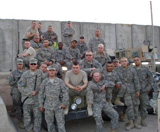Granby High School Alumni
Norfolk, Virginia (VA)
Alumni Stories
Russell Theisen
Class of 1955
Ejection Procedure Change for T2V-1 Sea Star
By Russell E. Theisen IEEE-Life Senior Member
In 1954 Russ Theisen was a member of the US Marine Corps Reserve unit VMA-233. The Reserve unit was flying The T2V-1 jet trainer aircraft. Prior to this aircraft VMA-233 flew the F4U Corsair, the AD-5 Douglas Sky Raider, F2h2- Banshee, and now the T2V-1 Sea Rider. This Air craft was the Navy and Marine Corps version of the Air Force T-33.
This was the two seat trainer version of the former P-80 Jet Aircraft.
There was a rumor that this aircraft had a very high mortality rate and no one could figure out why. Russ Theisen liked to fly whenever he could. One week end he asked the pilots if anyone would allow him to fly in the other seat, One (Lt). Anderson said that his second seat just became available because of sickness. And that I might fly with him if I did things his way. He said that I know that you have been checked out in the emergency escape procedures for this air craft but, if you want to fly with me you must agree to my way and not to the standard escape procedure, He then proceeded to tell me what his way was.
The normal escape procedure was for the Pilot to declare an emergency over the radio, eject the plastic canopy, pull your feet back off the rudder / brake pedals, yell Eject, Eject, Eject then pull the Curtin D-ring above your head down over your face and brace yourself for the tremendous kick in the pants because of the 90 mm cannon shell that was used to eject you in your seat high enough to clear the 12 foot vertical stabilizer directly behind you. This cannon shell was powerful enough to eject you and your seat above the vertical stabilizer if you were traveling at 600 miles an hour. This was the procedure that for some reason, yet undetermined, had an 85% mortality to the flight crew in this aircraft. They could not use a more powerful cannon shell such as an 110 mm because it would collapse your spine an kill you.
Lt Anderson told me that if he had to declare an emergency, he would yell Eject, Eject, Eject.
If he had to yell this three times that he was going to eject himself. When he did that, I could not get out of the Aircraft and would die when the Aircraft crashed.
One week end we were practicing touch and go landings. On the 5th or 6th touch and go touch downs we had a problem and the jet engine had a flame out as we were trying to gain altitude. We were just about 1000 feet and out of runway. Lt Anderson tried to restart the engine but it failed to restart. We did not have enough altitude to try another restart and we were flying over a train switching yard full of coal cars loaded with coal.
He yelled that he was declaring an Emergency. He called it in over the radio and tried to eject the canopy, the canopy eject mechanism failed to operate correctly and the canopy would not release from the aircraft. This was an “Oh Shit“moment, we had just found out why this T2V-1 had such a high mortality rating.
Lt. Anderson told me that we were going to eject through the canopy. I yelled over the radio “Canopy will not release – we are going through it” He yelled Eject, Eject, And I pulled my feet in off the rudder pedals and reached up and grabbed the D ring above my head and pulled it down across my face, Boom, I was hit in the butt with what felt like getting hit by a Mac Truck and then I got hit on the head with a sledge hammer as I broke through the canopy with my head.
Damn that was violent.
My parachute deployed as I cleared the vertical stabilizer.
It only took me a few seconds to hit the ground. I blacked out. When I gained awareness, My back was killing me, my head was hurting like a bad migraine, but I think that I did not die.
I landed between two coal cars and just laid there wondering what was next.
Soon I heard emergency sirens and saw fire trucks coming my way. The rescue crew strapped me to a back board and added a stabilizer to my head and carried me to the hospital where I was interviewed, X-rayed and checked out. I found out that Lt. Anderson was brought to the same hospital to be checked out also. We both lived.
After I left the hospital, I returned to the flight Line and was interviewed by my commanding Officer to find out what happened and how did we survive and why the aircraft didn’t.
I told him that the canopy did not release as it should, so we went through it. (Which was not the approved ejection procedure). This was relayed to the Flight Safety Board and the airplane manufacture. It seemed to be caused by a design flaw in the canopy release solenoid. The wiring was too small to carry the current required to sufficiently activate the canopy release and eject the canopy.
The final change was to replace the ejection system with the MARK-4 Rocket Ejection system and replace the canopy release mechanism with an improved design. They also modified the standard ejection procedure to include the case where the canopy would not release.
Russell E. Theisen IEEE-Life Senior Member
By Russell E. Theisen IEEE-Life Senior Member
In 1954 Russ Theisen was a member of the US Marine Corps Reserve unit VMA-233. The Reserve unit was flying The T2V-1 jet trainer aircraft. Prior to this aircraft VMA-233 flew the F4U Corsair, the AD-5 Douglas Sky Raider, F2h2- Banshee, and now the T2V-1 Sea Rider. This Air craft was the Navy and Marine Corps version of the Air Force T-33.
This was the two seat trainer version of the former P-80 Jet Aircraft.
There was a rumor that this aircraft had a very high mortality rate and no one could figure out why. Russ Theisen liked to fly whenever he could. One week end he asked the pilots if anyone would allow him to fly in the other seat, One (Lt). Anderson said that his second seat just became available because of sickness. And that I might fly with him if I did things his way. He said that I know that you have been checked out in the emergency escape procedures for this air craft but, if you want to fly with me you must agree to my way and not to the standard escape procedure, He then proceeded to tell me what his way was.
The normal escape procedure was for the Pilot to declare an emergency over the radio, eject the plastic canopy, pull your feet back off the rudder / brake pedals, yell Eject, Eject, Eject then pull the Curtin D-ring above your head down over your face and brace yourself for the tremendous kick in the pants because of the 90 mm cannon shell that was used to eject you in your seat high enough to clear the 12 foot vertical stabilizer directly behind you. This cannon shell was powerful enough to eject you and your seat above the vertical stabilizer if you were traveling at 600 miles an hour. This was the procedure that for some reason, yet undetermined, had an 85% mortality to the flight crew in this aircraft. They could not use a more powerful cannon shell such as an 110 mm because it would collapse your spine an kill you.
Lt Anderson told me that if he had to declare an emergency, he would yell Eject, Eject, Eject.
If he had to yell this three times that he was going to eject himself. When he did that, I could not get out of the Aircraft and would die when the Aircraft crashed.
One week end we were practicing touch and go landings. On the 5th or 6th touch and go touch downs we had a problem and the jet engine had a flame out as we were trying to gain altitude. We were just about 1000 feet and out of runway. Lt Anderson tried to restart the engine but it failed to restart. We did not have enough altitude to try another restart and we were flying over a train switching yard full of coal cars loaded with coal.
He yelled that he was declaring an Emergency. He called it in over the radio and tried to eject the canopy, the canopy eject mechanism failed to operate correctly and the canopy would not release from the aircraft. This was an “Oh Shit“moment, we had just found out why this T2V-1 had such a high mortality rating.
Lt. Anderson told me that we were going to eject through the canopy. I yelled over the radio “Canopy will not release – we are going through it” He yelled Eject, Eject, And I pulled my feet in off the rudder pedals and reached up and grabbed the D ring above my head and pulled it down across my face, Boom, I was hit in the butt with what felt like getting hit by a Mac Truck and then I got hit on the head with a sledge hammer as I broke through the canopy with my head.
Damn that was violent.
My parachute deployed as I cleared the vertical stabilizer.
It only took me a few seconds to hit the ground. I blacked out. When I gained awareness, My back was killing me, my head was hurting like a bad migraine, but I think that I did not die.
I landed between two coal cars and just laid there wondering what was next.
Soon I heard emergency sirens and saw fire trucks coming my way. The rescue crew strapped me to a back board and added a stabilizer to my head and carried me to the hospital where I was interviewed, X-rayed and checked out. I found out that Lt. Anderson was brought to the same hospital to be checked out also. We both lived.
After I left the hospital, I returned to the flight Line and was interviewed by my commanding Officer to find out what happened and how did we survive and why the aircraft didn’t.
I told him that the canopy did not release as it should, so we went through it. (Which was not the approved ejection procedure). This was relayed to the Flight Safety Board and the airplane manufacture. It seemed to be caused by a design flaw in the canopy release solenoid. The wiring was too small to carry the current required to sufficiently activate the canopy release and eject the canopy.
The final change was to replace the ejection system with the MARK-4 Rocket Ejection system and replace the canopy release mechanism with an improved design. They also modified the standard ejection procedure to include the case where the canopy would not release.
Russell E. Theisen IEEE-Life Senior Member

Recent Members
| Bob Everton | 1961 |
| David Liebman David Liebman | 1962 |
| Dorothy Locke | 1968 |
| Jason Stewart | 1995 |
| Jennifer Jones | 1988 |
| Michael Allen | 1984 |
| Patricia Sherman | 1966 |
| Ron Hallman | 1962 |
Military Alumni
Honoring Our Heroes
This area is dedicated to our alumni that have served or are serving in our armed forces!
Lost Class Rings
Have you lost your Granby High School class ring? Have you found someone's class ring? Visit our Comets lost class ring page to search for your class ring or post information about a found ring.
Do you have a fun holiday story or a great family tradition? Share them with our fellow Granby High School alumni! Submit your own stories, achievements and photos in our Alumni Stories section. Read other classmate’s stories and see what they have been up to over the years.
Happy Holidays!
Happy Holidays!

